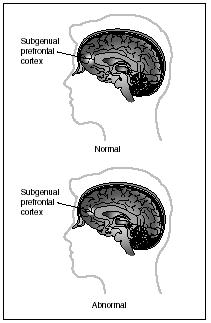Depressive Disorders - Description
Everyone experiences feelings of unhappiness and sadness occasionally. In some cases, however, these feelings can begin to take over a person's everyday life. They cause a person's physical and mental health to deteriorate.
Experts estimate that depressive disorders affect seventeen million Americans. One in four women is likely to experience at least one episode of depressive disorder in her lifetime. The rate is about one in eight among men. Depressive disorders can strike all age groups, from children to the elderly. The average age a first depressive episode occurs is in the middle twenties.
- Dysthymic disorder:
- An ongoing, chronic depression that lasts two or more years.
- Hypersomnia:
- The need to sleep excessively; a symptom of dysthymic and major depressive disorder.
- Neurotransmitters:
- Chemicals that occur in the brain and are responsible for carrying messages in the brain.
- Psychosocial therapy:
- Any means by which a trained professional holds interviews with a patient and tries to help that patient better understand himself or herself and the reasons for his or her thoughts and actions.
There are two types of depressive disorders: major depressive disorder and dysthymic (pronounced dis-THIH-mik) disorder. Major depressive disorder is defined as a depressive disorder with moderate to severe symptoms that lasts two or more weeks. The symptoms of major depressive disorder include trouble sleeping, loss of interest in once enjoyable activities, change in weight, difficulty in concentrating, feelings of hopelessness, and thoughts about death and suicide. In children, the main symptom of major depressive disorder is irritability (being easily upset).
Dysthymic disorder is a chronic (ongoing) form of depression that lasts at least two years (one year in children). The average period of time the disorder lasts is sixteen years. The symptoms of dysthymic disorder tend to be mild to moderate. They may be more intense at some times than at others. A person with dysthymic disorder may go for up to two months without feeling depressed. The disorder often comes on gradually. A patient may not even remember exactly when he or she started feeling depressed. Symptoms of dysthymic disorder include problems with sleeping and eating, low self-esteem (poor feelings about oneself), trouble concentrating, and feelings of hopelessness.
Depression can also occur in bipolar disorder (see bipolar disorder entry). Bipolar is a form of mental illness in which people feel wild swings of emotions. At one moment, they may feel happy and optimistic. At the next moment, they may feel sad and depressed.


Comment about this article, ask questions, or add new information about this topic: